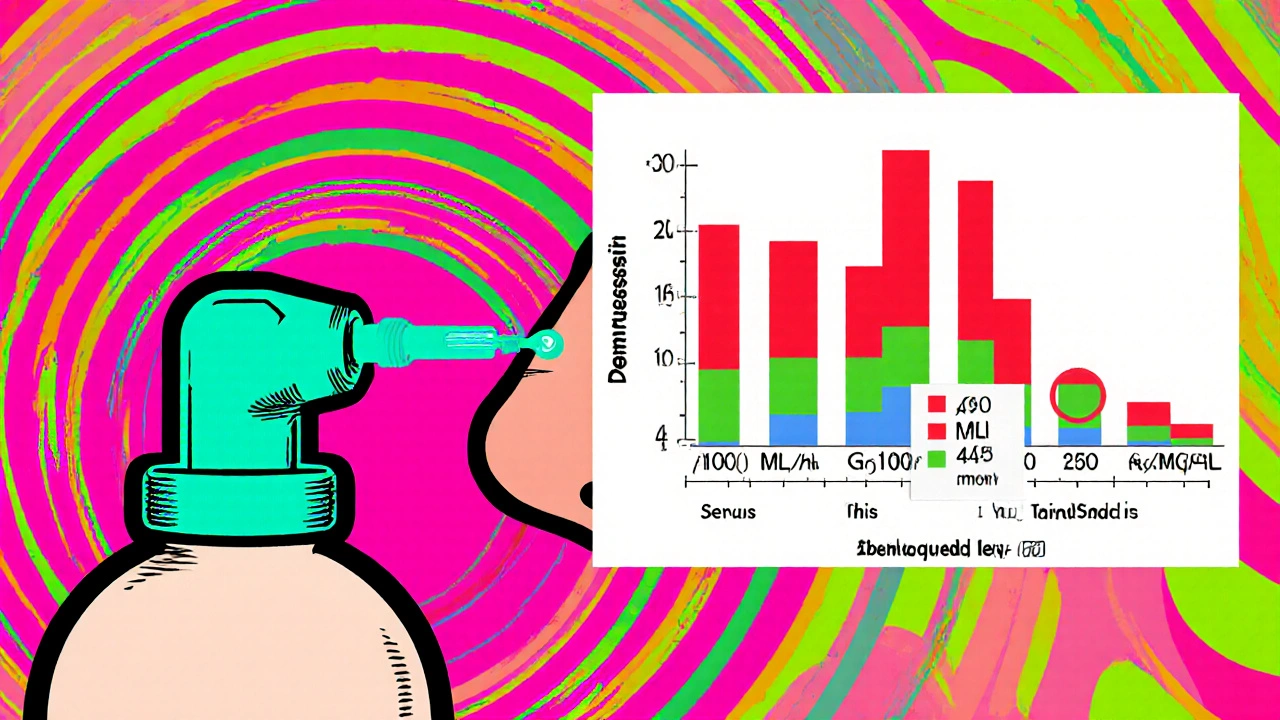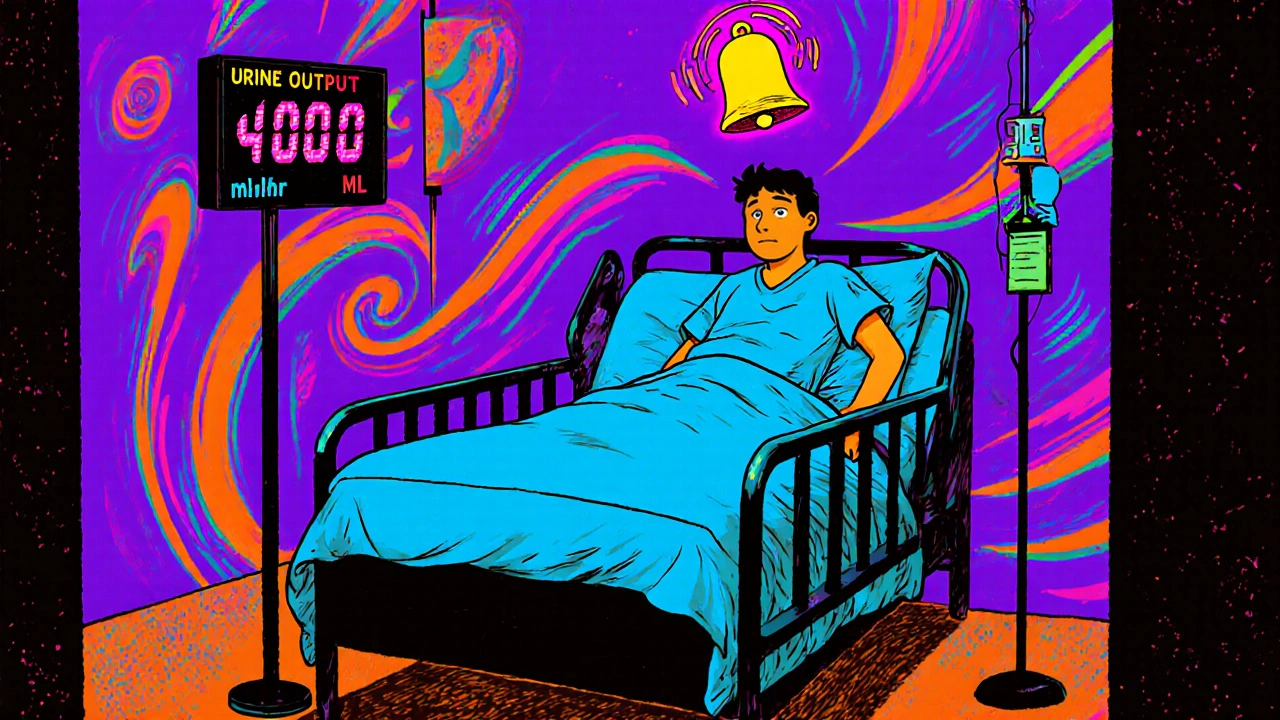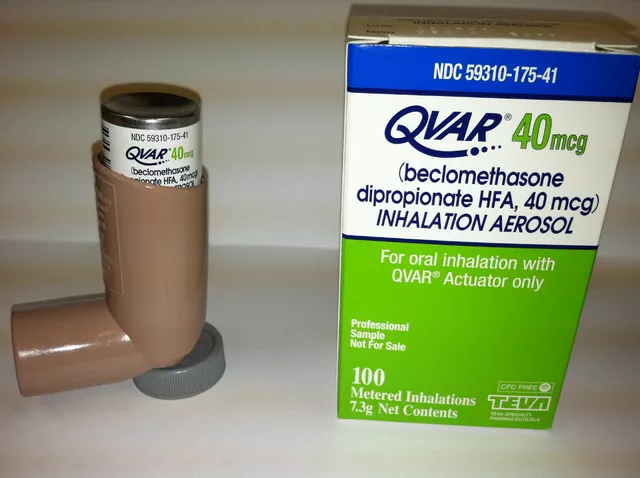Desmopressin Dosing Calculator
Calculate Desmopressin Dose
Select administration route and enter patient weight to calculate appropriate dose.
Calculated Dose
Enter patient information to see calculated dose
Important Safety Information
Monitor serum sodium every 4-6 hours initially. Target range: 135-145 mmol/L.
Signs of hyponatremia: nausea, headache, lethargy, seizures. If present, hold dose immediately.
When a patient wakes up after brain or pituitary surgery and starts making gallons of urine, the alarm bells start ringing. This sudden surge in output often signals postoperative diabetes insipidus (DI), a rare but serious hormone imbalance. The go‑to drug for most clinicians is Desmopressin, a synthetic vasopressin analog that tells the kidneys to hold onto water.
Understanding Post‑operative Diabetes Insipidus
Diabetes Insipidus (DI) is not related to the more common diabetes mellitus. It occurs when the body lacks enough antidiuretic hormone (ADH) or the kidneys can’t respond to it. After pituitary or hypothalamic surgery, the delicate wiring that releases ADH can be damaged, leading to a sudden drop in hormone levels. Without ADH, the kidneys let water free, creating a classic triad: polyuria (excessive urine), polydipsia (excessive thirst), and diluted urine.
The condition can develop within hours of surgery, and if untreated, patients can become severely dehydrated, develop hypernatremia, or suffer from low blood pressure. Early recognition hinges on monitoring urine output, serum sodium, and fluid balance.
How Desmopressin Works
Vasopressin, the natural hormone, binds to V2 receptors in the kidney’s collecting ducts, prompting them to re‑absorb water. Desmopressin mimics this action but is more selective, so it has fewer side‑effects like vasoconstriction. By activating the same V2 pathway, it reduces urine volume and concentrates the urine, bringing serum sodium back toward normal.
Case Study Snapshot
Patient: 42‑year‑old male, underwent trans‑sphenoidal resection of a non‑functioning pituitary adenoma. Immediate postoperative labs were unremarkable. By postoperative day (POD) 1, urine output spiked to 400 mL/hour, and serum sodium climbed from 138 mmol/L to 150 mmol/L. The nursing team noted the patient’s intense thirst and dry mucous membranes.
Intervention: The endocrinology consult ordered a Desmopressin trial. An initial intranasal dose of 10 µg was given, followed by close monitoring of urine output, serum sodium, and weight.
Outcome: Within two hours, urine output fell to 150 mL/hour, and serum sodium dropped to 143 mmol/L. The patient remained stable, and the dose was tapered to a maintenance intranasal 5 µg nightly. He was discharged on POD 5 with oral desmopressin 0.1 mg daily and instructions for fluid intake.
Dosing Strategies & Routes of Administration
Desmopressin can be given intranasally, orally, or intravenously (IV). Choice depends on severity, patient’s ability to swallow, and need for rapid control. Below is a quick reference comparing the three routes.
| Route | Typical Dose | Onset | Duration | Key Considerations |
|---|---|---|---|---|
| Intranasal | 10‑20 µg once or twice daily | 30‑60 min | 6‑12 hr | Easy for conscious patients, but nasal congestion can affect absorption. |
| Oral (tablet or melt) | 0.1‑0.4 mg once daily | 1‑2 hr | 12‑24 hr | Preferred for discharge planning; dose titration is straightforward. |
| IV | 1‑2 µg bolus, then 0.5‑1 µg/hr infusion | 5‑10 min | Variable, depends on infusion rate | Best for severe, acute DI or when oral/nasal routes unavailable. |
Monitoring & Safety Checks
Once desmopressin is started, vigilant monitoring prevents over‑correction, which can lead to hyponatremia- a potentially fatal drop in serum sodium.
- Urine output: Aim for 0.5‑2 mL/kg/hr after therapy begins. Sudden drops signal excess dosing.
- Serum sodium: Check every 4‑6 hours initially. Target 135‑145 mmol/L. A decline >10 mmol/L in 24 hr warrants dose reduction.
- Weight and fluid balance: Record daily weight and fluid input/output chart.
- Hyponatremia signs: Nausea, headache, lethargy, seizures. If they appear, stop desmopressin and give hypertonic saline if needed.
When patients transition from IV to oral or intranasal routes, a short overlap period (often 12‑24 hr) helps maintain steady hormone levels.

Managing Complications
If urine output stays high despite adequate dosing, consider a missed dose, nasal blockage, or an alternate diagnosis like osmotic diuresis. Conversely, if output falls too low, look for signs of water retention and adjust the dose downward.
In rare cases, patients develop Hyponatremia from excessive desmopressin. The remedy is simple: hold the next dose, restrict free water, and correct sodium slowly (<8 mmol/L per 24 hr) to avoid central pontine myelinolysis.
Practical Nursing Checklist
- Confirm order: drug, route, dose, and timing.
- Baseline labs: serum sodium, potassium, creatinine, urine specific gravity.
- Administer desmopressin via chosen route.
- Record urine output hourly for the first 6 hr.
- Re‑check serum sodium at 4‑hr intervals.
- Adjust dose based on output and sodium trends.
- Educate patient on signs of over‑correction (headache, confusion).
- Document fluid intake, output, and weight daily.
Key Take‑aways
- Post‑operative DI can appear quickly; monitor urine output and sodium from the moment the patient leaves the OR.
- Desmopressin is the first‑line agent; choose the route that matches the clinical scenario.
- Safety hinges on frequent sodium checks and respecting the narrow therapeutic window.
- Transition to oral or intranasal dosing before discharge to simplify home care.
What triggers postoperative diabetes insipidus?
Surgery that disturbs the pituitary stalk or hypothalamus can interrupt antidiuretic hormone release, leading to a sudden drop in ADH and excess urine production.
How quickly does desmopressin start working?
Intranasal doses act within 30‑60 minutes, oral tablets within 1‑2 hours, and IV boluses as fast as 5‑10 minutes.
Can desmopressin cause low sodium?
Yes. Over‑dosing can trap too much water, diluting serum sodium. Routine labs and urine checks catch this early.
What is the best route for discharge planning?
Oral tablets or melt‑away forms are preferred for home use because they are easy to dose and have a predictable duration.
How do I know if the dose is too high?
Watch for urine output dropping below 0.5 mL/kg/hr, a rapid fall in serum sodium, or symptoms like headache and nausea.








October 21, 2025 AT 18:05
eric smith
Oh great, another post about Desmopressin like we needed a refresher on water balance. Because who doesn’t love a hormone that tells your kidneys to hold onto every drop of H2O? The post even throws in a fancy table-wow, groundbreaking. I’m sure nobody in the world has ever seen a dosage chart before. And that case study? A 42‑year‑old dude making gallons of pee? Riveting stuff. Maybe next time throw in a superhero who rescues the patient with a magic IV drip. But hey, thanks for the reminder that we should all keep an eye on urine output after brain surgery. 🙄
October 24, 2025 AT 01:38
Eryn Wells
Hey Eric, love the humor! 😄 It’s so important to keep the vibe light when we’re talking about something as serious as post‑op DI. Desmopressin really does save the day for many patients, and the table you highlighted is super helpful. 🌟 Thanks for summarizing the key points so nicely, everyone! 🎉
October 26, 2025 AT 08:12
Kathrynne Krause
What a fantastic thread! 🎨 I’m thrilled to see the community rallying around such a vital topic. The way Desmopressin orchestrates water re‑absorption is like a maestro conducting a symphony-truly poetic. 🌈 Let’s keep the conversation buzzing, sharing tips on dosing nuances and patient stories. Together we’ll turn the post‑op pitfall of polyuria into a triumph of balanced fluids! 💪
October 28, 2025 AT 15:45
Jasmina Redzepovic
Listen up, folks. This isn’t just about “saving the day” with a synthetic analog; it’s about understanding the underlying neuro‑endocrine circuitry that the United States pioneered in pituitary research. The pharmacokinetics of intranasal vs. IV desmopressin involve V2‑receptor affinity constants that many clinicians overlook. If you’re not calibrating doses based on serum osmolality, you’re basically flying blind. Let’s be precise, not just cute with emojis. 🇺🇸
October 31, 2025 AT 13:12
Kimberly Lloyd
Reading this brings a sense of calm optimism. The balance between vigilance and compassion is key-monitor those sodium levels, yes, but also reassure the patient that their thirst is being managed. It’s a dance of science and humanity, and every successful discharge is a small victory for all of us who care. 🌿
November 3, 2025 AT 10:38
Sakib Shaikh
Oh wow, this is sooo amazing! I mean, desmopressin is like the superhero of DI-no capes, just pure hormone power. I cant even... like, how many times do we have to say “check urine output”?? It's literally the golden rule. And the dosage tables? SAME SAME, but sooo helpful! 😂
November 6, 2025 AT 08:05
Devendra Tripathi
Honestly, I think the whole hype around Desmopressin is overblown. Sure, it reduces urine volume, but have you considered the risk of severe hyponatremia? In many cases, conservative fluid management can be just as effective without the pharmacologic baggage. Let’s not rush to medicate every post‑op patient.
November 9, 2025 AT 19:25
Nick M
Everything’s a conspiracy.
November 13, 2025 AT 06:45
Eli Soler Caralt
Ah, the mere mortals attempt to grapple with the nuanced intricacies of antidiuretic therapeutics. One must appreciate the epistemological underpinnings of fluid homeostasis, lest we descend into naïve babble. 🌌
November 16, 2025 AT 18:05
Angela Koulouris
Great resource, keep up the good work!
November 20, 2025 AT 19:18
Harry Bhullar
Let’s break this down step by step for anyone who’s new to post‑operative DI management. First, the pathophysiology: after pituitary surgery, the posterior lobe may be traumatized, resulting in an acute deficiency of arginine vasopressin (AVP). Without AVP, the kidneys lose their ability to insert aquaporin‑2 channels into the collecting duct membrane, leading to massive free water loss and the classic triad of polyuria, polydipsia, and hypernatremia. Second, the diagnostic work‑up: monitor hourly urine output, spot‑check serum sodium every 4‑6 hours, and compare urine osmolality to serum osmolality; a urine osmolality that is inappropriately low despite hypernatremia is diagnostic. Third, the therapeutic options. Desmopressin is the drug of choice because it selectively agonizes V2 receptors without significant V1‑mediated vasoconstriction. The three main routes-intranasal, oral, and IV-each have distinct pharmacokinetic profiles. Intranasal administration yields a rapid onset (30‑60 minutes) and a duration of 6‑12 hours, but nasal congestion can impair absorption. Oral tablets have a slower onset (1‑2 hours) but provide a more stable 12‑24 hour coverage, making them ideal for discharge planning. IV infusion is reserved for severe, uncontrolled DI or when the patient cannot tolerate the other routes; the bolus effect is seen within minutes, and the infusion can be titrated precisely. Fourth, dosing titration: start low, typically 10‑20 µg intranasally or 0.1 mg orally, then adjust based on urine output and serum sodium trends. Aim for a urine output of 0.5‑2 mL/kg/hr; a sudden drop below 0.5 mL/kg/hr indicates possible over‑replacement and risk of hyponatremia. Fifth, monitoring for complications: hyponatremia is the most feared adverse effect; a drop in serum sodium greater than 10 mmol/L in 24 hours warrants dose reduction or temporary cessation. Watch for neurologic signs-headache, nausea, lethargy, seizures-as early warnings. Finally, transition strategies: when moving from IV to oral or intranasal routes, overlap for 12‑24 hours to avoid gaps in AVP activity, and educate the patient on fluid intake, signs of over‑hydration, and the importance of adherence. In summary, this protocol provides a comprehensive framework that balances rapid correction of electrolyte derangements with cautious titration to prevent iatrogenic hyponatremia, ultimately improving patient outcomes after pituitary surgery.
November 24, 2025 AT 20:32
Dana Yonce
Very clear guide, thanks! :)
November 28, 2025 AT 21:45
Lolita Gaela
The pharmacodynamics of desmopressin involve selective V2‑receptor agonism, which enhances aquaporin‑2 trafficking to the apical membrane of principal cells. This reduces free water clearance (CH2O) and increases urine osmolality. When calculating dose adjustments, consider the patient's renal clearance, concurrent nephrotoxic agents, and baseline serum sodium. A pragmatic algorithm: if urine output >2 mL/kg/hr, increase dose by 10‑20 %; if serum sodium >148 mmol/L, reduce dose by 10 % and re‑evaluate fluid balance. Avoid abrupt discontinuation to prevent rebound DI.
December 2, 2025 AT 22:58
Giusto Madison
Spot on, Harry! I’d add that clinicians should keep a tight log of intake‑output charts-digital tools work wonders. Also, patient education on the signs of hyponatremia can’t be overstated. Let’s keep sharing these practical nuggets.